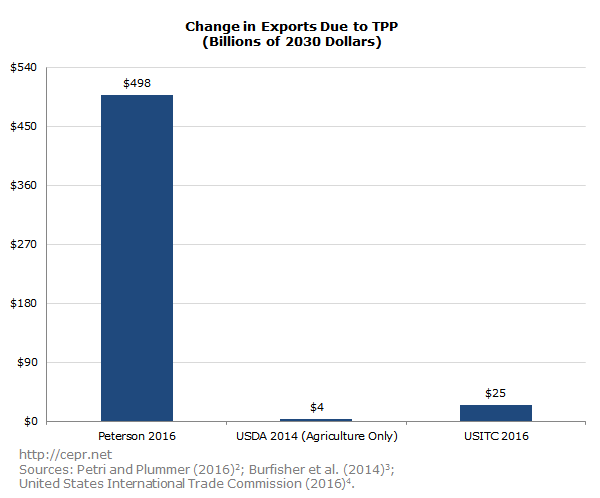May 19, 2016
The United States International Trade Commission (USITC) recently came out with projections on the economic effects of the Trans-Pacific Partnership (TPP) trade deal. The USITC’s report is the third major study on the TPP from the past two years. The USITC is legally required to provide this report.
The USITC report shows that the TPP would have relatively little impact on the volume of trade. This is consistent with the projections from a study by the United States Department of Agriculture (USDA) (which only examined the impact on agriculture), but is far out of line with the projections by the Peterson Institute for International Economics, the producer of the third major study.
Figure 1 below shows the change in total exports projected in the USITC report and the Peterson Institute study, and the projected increase in agricultural exports from the USDA study.[1]
The USITC study projects that exports will increase by less than 1.0 percent when the effects of the TPP are fully felt in 2032. The USDA study also projects an increase in agricultural exports of less than 1.0 percent. By contrast, the Peterson Institute projects that exports would rise by $498 billion as a result of the TPP, an increase in exports of 9.1 percent against its baseline. This increase is more than an order of magnitude larger than the increase in exports projected by the USITC or the USDA relative to their baselines. (The USDA baseline of course only refers to agricultural exports.)

Figure 2 presents the same figures but for imports. Since the models fix the size of the trade deficit by construction (the USITC models sets it at 0.9 percent of GDP, while the Peterson Institute model basically holds it constant), it is inevitable that the story on imports would mirror the picture with exports.

It is striking that the Peterson Institute projections are so far out of line with those produced by the USITC and the USDA. Clearly it is using assumptions that imply the TPP will have a far larger impact than those used in the other two modeling exercises.
[1] All estimates are presented in 2030 dollars (using data from the St. Louis Federal Reserve and projections from the Congressional Budget Office).
[2] Petri, Peter A., and Michael G. Plummer. The Economic Effects of the Trans-Pacific Partnership: New Estimates. Working Paper 16-2. January 2016. Peterson Institute for International Economics.
[3] Burfisher, Mary E., John Dyck, Birgit Meade, Lorraine Mitchell, John Wainio, Steven Zahniser, Shawn Arita, and Jayson Beckman. Agriculture in the Trans-Pacific Partnership. Economic Research Report #176. October 2014. United States Department of Agriculture, Economic Research Service.
[4] United States International Trade Commission. Trans-Pacific Partnership Agreement: Likely Impact on the U.S. Economy and on Specific Industry Sectors. Publication Number 4607. May 2016. United States International Trade Commission.






